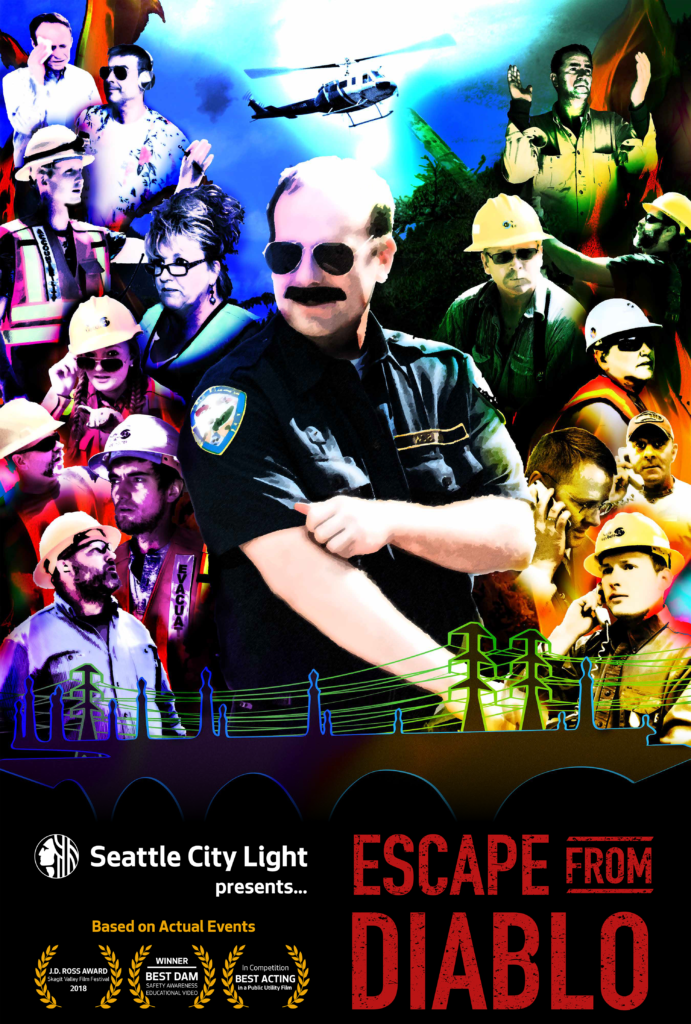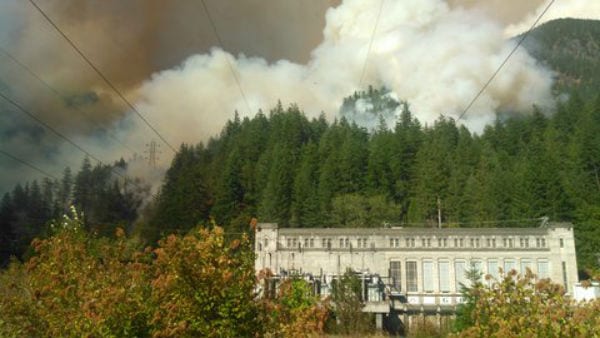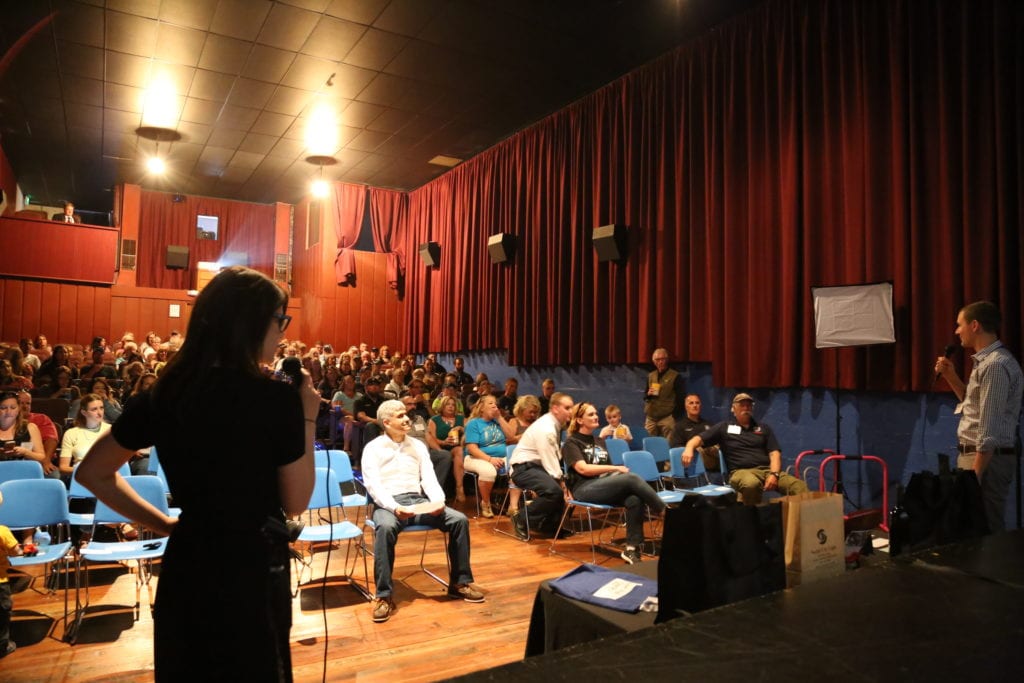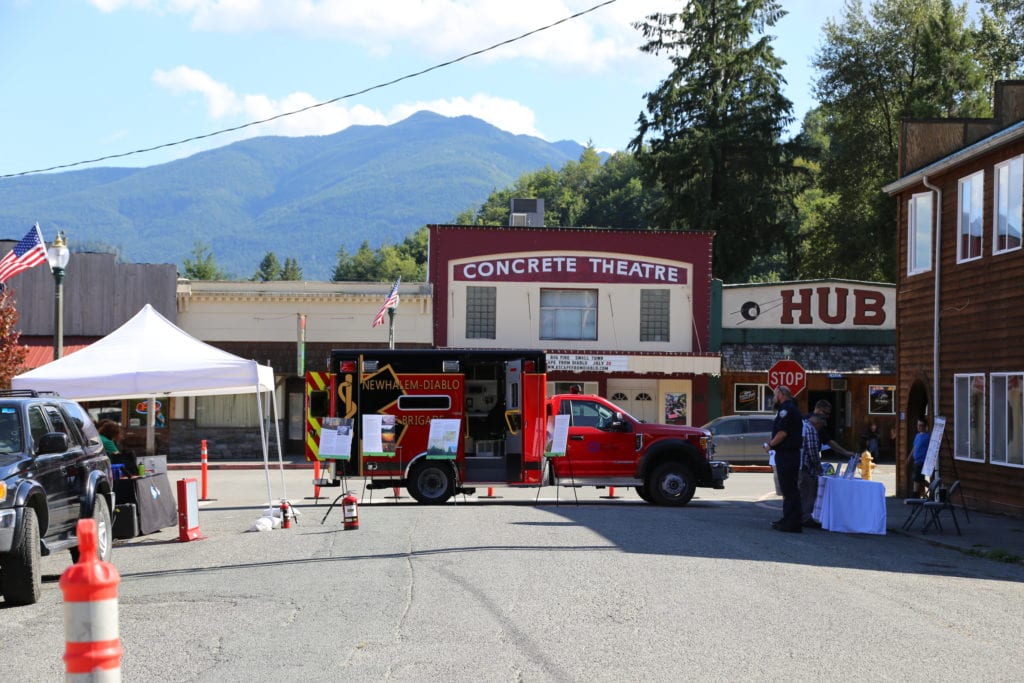
This story was published originally in the June 2019 issue of Northwest Public Power Association Bulletin Magazine. Please note: positions and titles of contributors may have changed since the time of original publication.
Safety is paramount to our line of work, regardless if you are stationed in an office, a warehouse, or in the field. There are safety protocols for nearly any task or project, and those protocols typically are communicated through staid training videos that often amount to someone reading an instruction manual.
But what if training films were produced like an action movie? What if they opened with a description like this?
It’s a summer morning in Western Washington. A utility right-of-way crew sees a raging fire swallowing the mountainside racing towards a hydroelectric powerhouse. Employees race to evacuate with their loved ones as firefighters battle the flames and protect their beloved community. Will they all evacuate the area in time…safely!?
While this may feel like the trailer of the next summer blockbuster, this actually sets the scene for the opening of an evacuation protocol film produced by Seattle City Light for its Skagit Hydroelectric Project.
In 2017, City Light Videographer Koryn Kennedy and City Light’s Newhalem-Diablo Fire Brigade Chief Cody Watson wanted to make an instructional film for the communities of Diablo (Die-ab-low) and Newhalem. City Light employees, who work at the dams that City Light owns and operates, and their families live in these towns. The goal was to lay out the steps of what to do during an evacuation and they wanted to ensure that it was entertaining, educational, and, most importantly, memorable in a time of crisis.
This idea led to the creation of “Escape from Diablo” (“EFD”), a 12-minute safety film that includes action movie archetypes with Skagit Hydroelectric Project employees serving as the acting talent. The project grew to become more than a film, bringing a community together and transforming a standard safety procedure into something unforgettable.

Learning from the past
“EFD,” although funny at times, was inspired by an unprecedented and destructive event: the Goodell Creek Fire. In 2015, lightning struck Ross Mountain in the North Cascades National Park Complex, less than a mile away from the Skagit Hydroelectric Project. The combination of the blaze engulfing the area in flames and the limited amount of aid and resources available put the project at risk. As the fire reached the boundaries of City Light’s facilities, the utility evacuated all of its employees and residents, along with visitors to the area.
The utility and its Newhalem-Diablo Fire Brigade also provided support for the surrounding resorts, national park centers, and small towns within the area. It took nearly 20 days to contain the fire even with the support of 300 volunteer firefighters. All told, the fire burned more than 8,000 acres and cost the utility $2.2 million in damages, response, and labor, along with $900,000 of power purchases and generation loss. Thankfully, no significant injuries were reported.
“The Goodell Creek Fire became a jarring reminder that wildfires in Western Washington, which were unheard of, were now a present threat to our region,” said Watson. “Following the fire, we established evacuation procedures, so both City Light employees and residents of Diablo and Newhalem know what to do in the event of an emergency.”

Lights, camera, action!
Kennedy had her work cut out for her. She was the director, producer and entire production team of “EFD,” with occasional support from an intern or colleague willing to hold a boom mic. Most of the footage needed to be filmed at the Skagit Hydroelectric Project, roughly 130 miles northeast of her office in Seattle, and she had to coordinate the cast of 20 City Light employees. Nevertheless, filming took place over a few months and garnered more excitement with each shoot.
“EFD” is set during a fire similar to the Goodell Creek Fire that’s approaching Newhalem and Diablo. With little time to act, the City Light employees implement the new evacuation plan created by Watson and his team. Each scene goes through the procedure step by step with intermittent pauses to define critical terms typed out on the screen. Finally, the community evacuates the area safely because they followed protocol even if at times it may have been easier to cut corners. “EFD” closes with Watson (the protagonist in the Aviator sunglasses and fake mustache) explaining that the film was created to provide a visual element for their plan.
Along with its instructional aspect, “EFD” was written with a niche audience in mind: the tight-knit community of Skagit Hydroelectric Project employees who are not just coworkers but neighbors and friends. Kennedy ensured that “EFD” honored that community. With that in mind, the film includes a myriad of inside jokes suggested by the employees/actors explicitly meant for the community while still being funny to a larger audience. It was authentic, lighthearted, and never lost sight of the seriousness of the subject at hand.
“I believe there are three things that connect people: humor, cultural references, and people they know,” Kennedy explained. “‘Escape from Diablo’ is fun to watch because it’s not taking the subject lightly. Instead, it uses humor and the target audience is in on the joke. The actors were willing to be a little campy because they care so much about their community. They want to make sure that everyone remembers what to do when disaster strikes.”

“Escape from Diablo” at the Concrete Theatre
Taking “Escape from Diablo” to the big screen
With “EFD” in the can, Kennedy and Watson were ready for its debut. But how can a film of its magnitude just be relegated to a YouTube channel only to be referenced occasionally? A film like this called for a premiere. That’s when Kennedy and Watson brought in Chris Armstrong, City Light’s senior outreach and engagement specialist, to help organize the Baker Street Block Party, a community event in Concrete, Wash., near the Skagit Hydroelectric Project. Armstrong worked on premiering the film at the block party and providing the surrounding communities with an opportunity to connect with City Light and local emergency management agencies in a unique way.
“This might be the first event I’ve planned that was over 100 miles away,” Armstrong said, laughing. “City Light’s Communications team doesn’t work or live in the area, but our employees do. We turned to them for guidance regularly to find out who we needed to connect with locally. Engaging with those stakeholders was vital to ensure that it wasn’t just a team from Seattle trying to put on an event. Having advocates who grew up in that community was crucial.”
Early on, the City Light team connected with Valerie Stafford, the owner of the Concrete Theatre and president of the Concrete Chamber of Commerce. She loved the idea of a premiere and was happy to connect the community with City Light.
On a warm July night in 2018, “EFD” was ready for its premiere at the Baker Street Block Party. The party included a “touch-a-truck” with emergency vehicles of all kinds for the kids, safety tips from local agencies for the parents, and a time for the utility to connect with its neighbors. The event also included a display describing the Goodell Creek Fire, and even Smokey Bear made an appearance. The premiere included two showings of the film at the Concrete Theatre followed by panel discussions with local emergency management officials and a climatologist from the University of Washington to discuss current protocols and the increasing threat of wildfires in the area due to climate change.
The sold-out crowds loved the film. They cheered for their coworkers on screen, laughed at the inside jokes, and asked specific questions to find out how they could prepare in case of an emergency.
“The local community was impressed that City Light put so much effort into bringing such a fun and informative event to our area,” said Stafford. “To have a few hundred people attend an event like this is huge and speaks to what it meant to our community.”

Reaching the communities your utility impacts
Like other utilities, City Light operates in communities outside of its service territory. Though opportunities to connect directly with these communities at this level may be rare, it’s essential to identify them as they arise to provide a potentially lasting impact while fostering new relationships.
For Jenny Levesque, City Light’s community outreach manager, even though communities like those near the Skagit Hydroelectric Project aren’t City Light customers, the utility’s presence is apparent and affects their lives.
“It’s important to be aware of the impact we have in these communities and for them to know that they are appreciated,” Levesque explained. “The event in Concrete was an opportunity for us to connect with our employees while giving back to the local community.”
Since the “EFD” premiere and Baker Street Block Party, the event has been recognized as a best practice for utilities and public safety agencies alike. It has been referenced at conferences and is still a topic of conversation throughout City Light. At its core, “EFD” exemplifies City Light’s value of safety and to ensure that standard operating procedures are followed during a catastrophe.
“Any project that aligns and promotes your utility’s values should be embraced and celebrated,” said Faz Kasraie, City Light’s generation operations and engineering director who helped champion the project. “The film and the event never lost sight of the importance that we value the lives of our employees, their families, and their communities.”